Fairchild

|
| 1949 advertisement (Image rights) |

|
| image by Dirk HR Spennemann (Image rights) |
The Fairchild Aerial Camera Corporation, founded in 1920 by the inventor and entrepreneur Sherman Mills Fairchild (April 7, 1896 - March 28, 1971)[1] was the manufacturer of a range of aerial cameras.
Contents
- 1 Background
- 2 Aerial Cameras
- 2.1 F-1
- 2.2 F-8
- 2.3 F-14
- 2.4 F-17
- 2.5 F-56
- 2.6 F-505
- 2.7 K-3A
- 2.8 K-6
- 2.9 K-7C
- 2.10 K-10
- 2.11 K-14
- 2.12 K-17
- 2.13 K-18
- 2.14 K-19B
- 2.15 K-20
- 2.16 K-22
- 2.17 K-24
- 2.18 K-25
- 2.19 K-37
- 2.20 KA-1
- 2.21 KA-2
- 2.22 KA-23A
- 2.23 KA-54
- 2.24 KA-56
- 2.25 KA-60
- 2.26 KA-66
- 2.27 KA-71
- 2.28 KA-72
- 2.29 KA-82
- 2.30 KA-89
- 2.31 KA-92
- 2.32 KB-18
- 2.33 KC-1
- 2.34 KS-25
- 2.35 KS-120
- 3 Oscillograph Cameras
- 4 Portrait Cameras
- 5 Camera Transits
- 6 Movie Cameras
- 7 Other
- 8 Notes
Background
Sherman M. Fairchild was born in Oneonta, New York, in April 1896 as the only child of congressman and a founder of International Business Machines (IBM), George W Fairchild. Sherman attended college at Harvard, the University of Arizona, and Columbia, studying engineering and aerial photography (graduating from none of them). In 1917 Fairchild was rejected from the US military because of poor health. Determined to help with the war effort, he and his father went to Washington to see if his experience with cameras might be helpful. At the time, the aerial cameras available to the US Army produced poor quality images because the camera's slow shutter speed could not keep up with the motion created by the airplane.
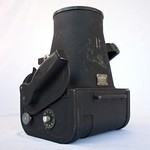
|
| K-20 (Image rights) image by Dirk HR Spennemann |
Fairchild developed a camera with an between-the-lens shutter which produced much clearer images. Even though the Army did not accept his camera until World War I had ended, it acquired two units for training. Fairchild started the Fairchild Aerial Camera Corporation in February 1920 as a vehicle to built and distribute his aerial cameras. Soon after the US Army placed orders for the and made the Fairchild the standard military camera.[2]
Aerial Cameras
Aerial Cameras produced by Fairchild:
F-1
Hand-held camera for aerial obliques, 5 x 7 format; black finish with wooden hand grips, with Carl Zeiss Tessar 250mm/f4.5 lens [3]
F-8
The F-8 was a focal plane shutter camera for oblique aerial photos, manufactured by Fairchild, fitted with a Schneider Xenar 240mm/f8. It was built during World War II under licence by Keystone and fitted with a Wollensak 375mm /5.6.
F-14
Hand-held camera for aerial obliques, 7 x 7 format; black wrinkle finish with wooden hand grips, with Bausch and Lomb lens-astigmat 8 1/4in. f:4,[4]
F-17
An
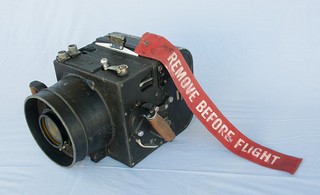
|
| Fairchild F-56 Aerial Camera with 8-inch cone image by Dirk HR Spennemann (Image rights) |
F-56
Fairchild F-56, a reconnaissance camera, primarily operated by the US Navy, fitted with a range of lens cone options:
- 5.25-inch / f6.3
- 8.25-inch / f4
- 20-inch / f5
- 40-inch / f8
F-505
The F-505 Aircraft Camera with 360mm f5.5 Tele-Xenar lens and a focal plane shutter could use 4x5 film sheets or 5inch rollfilm.
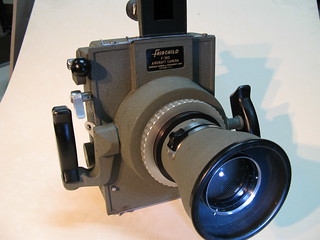
|
| F-505 Aircraft Camera image by John Bosko (Image rights) |
K-3A
Aerial mapping camera with automatic data imprint. With aerostigmat lens 12-inch/f5[5]
K-6
A large camera for oblique aerials, produced before 1929 and used by Bradford Washburn for many of his images of mountains and gaciers in Alaska.[6]
K-7C
A Medium to High Altitude Reconnaissance Camera for 9 1/2" wide roll film , comprised of a single-unit housing.
K-10
5x7inch aerial camera for rollfilm or film sheets, with 24cm f4.5 Schneider Xenar lens, focal plane shutter and Newton type finder.
K-14
Spotting camera. A hand-held camera, with a Kodak 95 mm lens and a focal plane shutter, was used by the pilot for recording points of interest while on general reconnaissance missions. With Kodak 95/ f3.5 lens.[7]
K-17
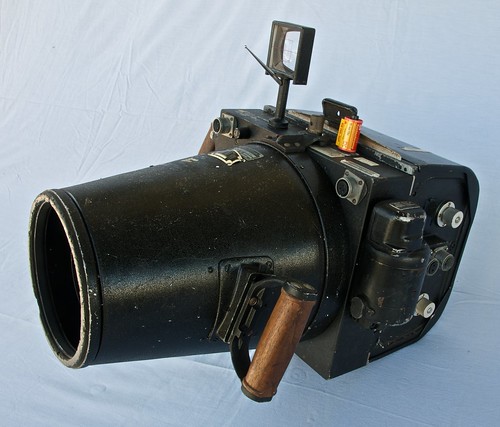
|
| Fairchild K-17A Aerial Camera image by Dirk HR Spennemann (Image rights) |
The K-17 was a Reconnaissance and Mapping Camera for vertical and oblique aerial photos, using 9 1/2" wide roll film for 9" x 9" images (usually fitted with a 250 frame magazine). The camera came with a with a between-the-lens shutter in with exchangeable cones with Bausch and Lomb Metrogon lens of 6", 12" and 24" focal length [8]
- 6-inch / f6.3
- 12-inch / f5
- 24-inch / f6
K-18
The K-18 was a Medium to High Altitude Reconnaissance Camera with between-the-lens shutter for 9 1/2" wide roll film for 9" x 18" negatives. The camera was comprised of a single-unit housing and 24-inch / f6 focal length [8] Two types of film magazines could be fitted, the A-7 magazine with 45 exposures or the A-8 magazine with 245 exposures.
K-19B
The K-19B Night Reconnaissance Camera for 9" x 9" format with between-the-lens shutter, fitted with a 12-inch / f2.5 lens cone [8] The magazine held 250 exposures. The camera's shutter was triggered by a photocell which detected the ignition flash bombs/flares dropped by the photographer.
K-20
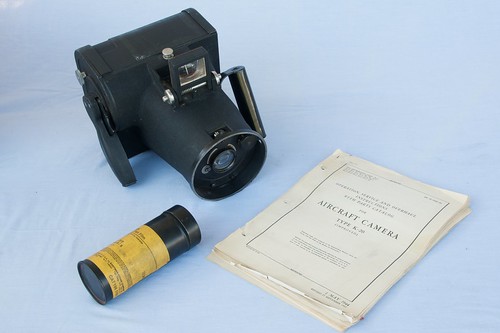
|
| Fairchild K-20 image by Dirk HR Spennemann (Image rights) |
The K-20 was a low altitude aerial camera for oblique photos, with a 6.375-inch / f4.5 lens, designed by Fairchild and manufactured under licence by Graflex as part of a military contract. Approximately 15,000 were manufactured by Folmer Graflex Corp. between 1941-1945. They use a 5.25"x20 to 5.25"x200 foot Roll Film, with an image size of 4x5 inches. The cameras were fitted with between-the-lens shutter and 6 3/8" f/4.5 non interchangeable lenses, made by either Kodak, Ilex, or Bausch & Lomb, as available at time of order. The large negative was held flat through the the use of a vacuum.[9]
K-22
An focal plane shutter camera for 9" x 9" format with a range of lens cone option. [8] The K-22 was electrically operated without an manual override option.
- 6-inch / f6.3
- 12-inch / f5
- 24-inch / f6
- 40-inch / f5
- 40-inch / f5.6
- 40-inch / f8

|
| 1949 ad (Image rights) |
K-24
The K-24 could be operated electrically.
K-25
An aerial camera for oblique photos, designed by Fairchild and manufactured under licence by Graflex
K-37
Camera designed for medium- to high-altitude night reconnaissance. Fitted with Kodak Aero-Ektar 305/f2.5.[10]
KA-1
Aerial Reconnaissance Still Picture Camera; manufactured by Fairchild; used in Martin RB-57E, RF-4, and RF-101A/C photo reconnaissance aircraft
KA-2
Aerial Reconnaissance Still Picture Camera; manufactured by Fairchild; used in A-26A, RF-84F, and RF-101A/C photo reconnaissance aircraft
KA-23A
Aerial Reconnaissance Still Picture Camera; manufactured by Fairchild.[11]
KA-54
Panoramic Camera; manufactured by Fairchild
KA-56
Low-Altitude Panoramic Camera; manufactured by Fairchild; used in RF-4, RF-5E, RF-8A/G, RF-101, RB-57E, F-111C (Australia) photo reconnaissance aircraft
KA-60
Panoramic High-Speed Aerial Still Picture Camera; manufactured by Fairchild; used in OV-1, RF-8A/G, AQM-34 photo reconnaissance aircraft
KA-66
Panoramic High-Speed Aerial Still Picture Camera (modified KA-60); manufactured by Fairchild; used in RF-8A photo reconnaissance aircraft
KA-71
Panoramic High-Speed Aerial Still Picture Camera (modified KA-60); manufactured by Fairchild; used in F-105G photo reconnaissance aircraft
KA-72
70mm Framing Camera; manufactured by Fairchild
KA-82
Medium-Altitude Panoramic Camera; manufactured by Fairchild; used in RB-57E, RF-4B photo reconnaissance aircraft
KA-89
Panoramic Camera; manufactured by Fairchild; used in AQM-34 photo reconnaissance aircraft
KA-92
Panoramic Camera; manufactured by Fairchild
KB-18
70mm Panoramic Strike Recording Camera; manufactured by Fairchild; fitted with a Carl Zeiss 75mm f/2.8 lens
- used in A-7D, F-4E, F-100F, O-2A, OV-10C, RF-111C (Australia), P-3C (Australia) photo reconnaissance aircraft
KC-1
Still Picture High-Altitude Mapping Camera; manufactured by Fairchild; used in RC-130A, RF-4 photo reconnaissance aircraft
KS-25
High-Acuity Aerial Reconnaissance Camera System; manufactured by Fairchild; used with ES-25 photo reconnaissance aircraft
KS-120
Panoramic High-Speed Aerial Still Picture Camera (KA-60C modified with larger 6000 ft. capacity magazine); manufactured by Fairchild; used in AQM-34 photo reconnaissance aircraft
Oscillograph Cameras
321-A Oscilloscope Record Camera
A camera designed to record the display of a Cathode Ray Oscilloscope. Fitted with a 400ft magazine the camera was capable of a range of recording speeds from 0.8 inches/sec to 10,800 inches/sec.[12]
Dumont Oscilloscope Record Camera
A move camera designed to record the the display of a Cathode Ray Oscilloscope. Fitted with Wollensak-Dumont CRO Oscillo-Anastigmat 75mm f/1.9[12]
F-246A
The F-246A Fairchild Oscilloscope Recording Camera was a cine camera with a slit system (strip camera) to to provide a continual record of the Oscilloscope waves. Used a 1000 ft magazine.[13]
F-284
A camera designed in 1951 to record the display of a Cathode Ray Oscillograph. The F-284 Fairchild Polaroid Oscilloscope Camera used body (but not the bellows) of a Polaroid Land Camera Model 95 fitted with a specially computed lens (Wollensak Oscillo-Anastigmat 75mm f/1.9)[12]
F-286
A camera designed to record the display of a Cathode Ray Oscillograph. Based on Polaroid Land Camera Model 95 with bellows fixed in extended position and fitted with a specially computed lens (Wollensak Oscillo-Anastigmat 75mm f/1.9)[12]
F-296
A camera designed in 1957 to record the display of a Cathode Ray Oscillograph. The Fairchild F-296 was based on a Polaroid Land Camera Model 95 and used a specially computedlens (Wollensak Oscillo-Anastigmat 75mm f/1.9)
T-453A
The Fairchild T-453A 4x5 "Oscilliscope Record Camera recorded single oscillograph images on 4x5" negatives. It was fitted with a Wollensak-Dumont CRO Oscillo-Raptar 75mm f/1.9[12]
Portrait Cameras
F-212
An automated portrait camera for 70mm film, powered by 115 Volts
F-340
Polaroid ID Camera with inbuilt flash system based on the Polaroid Land Camera Model 95.[12]
Camera Transits
F-227
The Fairchild F-227 Camera Transit comprised of a Keuffel & Esser Surveyor's Transit (type 5078-E) modified to support a 4x5" plate camera fitted with a Goerz Aerotar 8 1/4 f/6.8 in Wollensak Betax nº 4 shutter.[14]

|
| F-213 Fairchild-Smith 700 Film Developing Unit image by Dirk HR Spennemann (Image rights) |
Movie Cameras
- Fairchild Cinephonic Eight.—a magnetic sound-recording camera with three-lens turret (1960)[15]
Other
Other Photographica produced or distributed by Fairchild were
- F-213 Fairchild-Smith 700 Film Developing Unit (~1955)
- CCD201ADC, CCD imaging sensor of the first true digital camera (1975)
Notes
- ↑ Wikipedia entry on Sherman Mills Fairchild
- ↑ Fairchild Aviation Corporation by the US Centennial of Flight Commission
- ↑ National Air and Space Museum Object A19710962000
- ↑ National Air and Space Museum Object A19710963000
- ↑ National Air and Space Museum Object A19710957000
- ↑ Bradford Washburn's Fairchild K-6
- ↑ National Air and Space Museum Object A19620090000
- ↑ 8.0 8.1 8.2 8.3 Aerial Cameras by 20th Combat Mapping Squadron (archived)
- ↑ George Eastman House
- ↑ National Air and Space Museum Object A19970533000
- ↑ Example seen for sale with f/5.6 lens and 24V electric power.
- ↑ 12.0 12.1 12.2 12.3 12.4 12.5 Example seen in online auctions.
- ↑ Schowengerdt,E.E (1961) OSCILLOSCOPE CAMERAS FOR VIDEO RECORDING REENTRY PHYSICS PROGRAM. Lexington, MA: Lincoln Laboratory,Massachusetts Institute of Technology
- ↑ Spennemann, Dirk HR (2015) History, Description and Technical Details of the Fairchild camera transit F227. vers. 1.0 [CAMERA | TOPIA ] (Albury, NSW)
- ↑ Collecting Movie Cameras
Links
- Biography of Sherman Mills Fairchild (aircraft and aerial camera entrepreneur) at Butler County Warbirds
- Spennemann, Dirk HR (2015) History, Description and Technical Details of the Fairchild camera transit F227. vers. 1.0 [CAMERA | TOPIA ] (Albury, NSW).